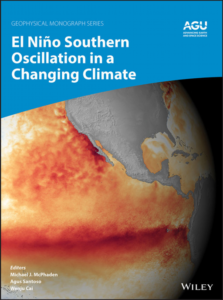Book release – ENSO in a changing climate
 El Niño is an unusual warming of the tropical Pacific that wreaks havoc on weather systems around the globe. It happens every few years and, like its cold counterpart La Niña, has profound effects on society and the environment. The irregular cycle between warm El Niño and cold La Niña events, referred to as El Niño Southern Oscillation, or ENSO, is the focus of a new book, El Niño Southern Oscillation in a Changing Climate, published by Wiley as part of the centennial celebration of the American Geophysical Union.
El Niño is an unusual warming of the tropical Pacific that wreaks havoc on weather systems around the globe. It happens every few years and, like its cold counterpart La Niña, has profound effects on society and the environment. The irregular cycle between warm El Niño and cold La Niña events, referred to as El Niño Southern Oscillation, or ENSO, is the focus of a new book, El Niño Southern Oscillation in a Changing Climate, published by Wiley as part of the centennial celebration of the American Geophysical Union.
“This is the first comprehensive examination of how ENSO cycle dynamics and impacts may change under the influence of rising greenhouse gas concentrations in the atmosphere”, said Michael McPhaden (U.S. National Oceanic and Atmospheric Administration (NOAA) and CSHOR Advisory Committee Member) who, along with Agus Santoso (University of New South Wales (UNSW) and CSHOR Project Leader) and Wenju Cai (CSIRO and CSHOR Director), served as editors of the book. “Global climate is changing because of human activities and how these changes affect ENSO is one of the most pressing problems in Earth system science today,” Cai added.
The book covers the latest theories, models, and observations, and explores the challenges of forecasting ENSO as the climate continues to change. “The book was initiated in the wake of the intense El Niño of 2015-16 that left a wide swath of destruction across the globe,” noted Santoso, adding, “Whether such extreme events are likely to increase in the future is an issue we address.”
The book’s 21 chapters are written by 98 experts from around the world. Highlights include the historical development of ideas about ENSO, a description of the underlying physical processes that generate ENSO variations, and how ENSO varies on decadal and longer time scales. Several chapters cover the impacts of ENSO on extreme events, fisheries, marine ecosystems, and the global carbon cycle. Advances in modeling, paleo-reconstructions, and operational climate forecasting are described as is the latest science on how ENSO responds to external factors such as forcing from outside the tropical Pacific, volcanic eruptions, and anthropogenic greenhouse gas forcing.
“At present, a La Niña is underway in the tropical Pacific and it is one of the reasons for the high-octane Atlantic hurricane season this year,” observed McPhaden. “Our book explains how ENSO affects severe tropical storms as well as other extreme weather and climate events like intense floods, searing droughts, and damaging marine heat waves.”
ENSO’s impacts are felt far and wide across the planet, for instance on agriculture, public health, fresh water availability, power generation, and economic activity. The book makes the case that, because it is so consequential, sustained and coordinated international efforts are needed to better observe, understand and predict ENSO and its effects on human and natural systems.
The book has been written to reach a wide audience, with up-to-date content that is authoritative, compelling, and of practical value. “By filling a gap in the literature on the topic of ENSO in a changing climate, we expect the book to have wide appeal, particularly with students, ENSO researchers, practitioners in other fields, and policy makers,” according to Santoso.
“The future will be different than the past and we need to be prepared”, said Cai. “The information in this book helps us prepare for that future.”
Read the Editors’ Vox on the Eos website at this link.
Thank you to Michael McPhaden for supplying most of the content contained in this post.